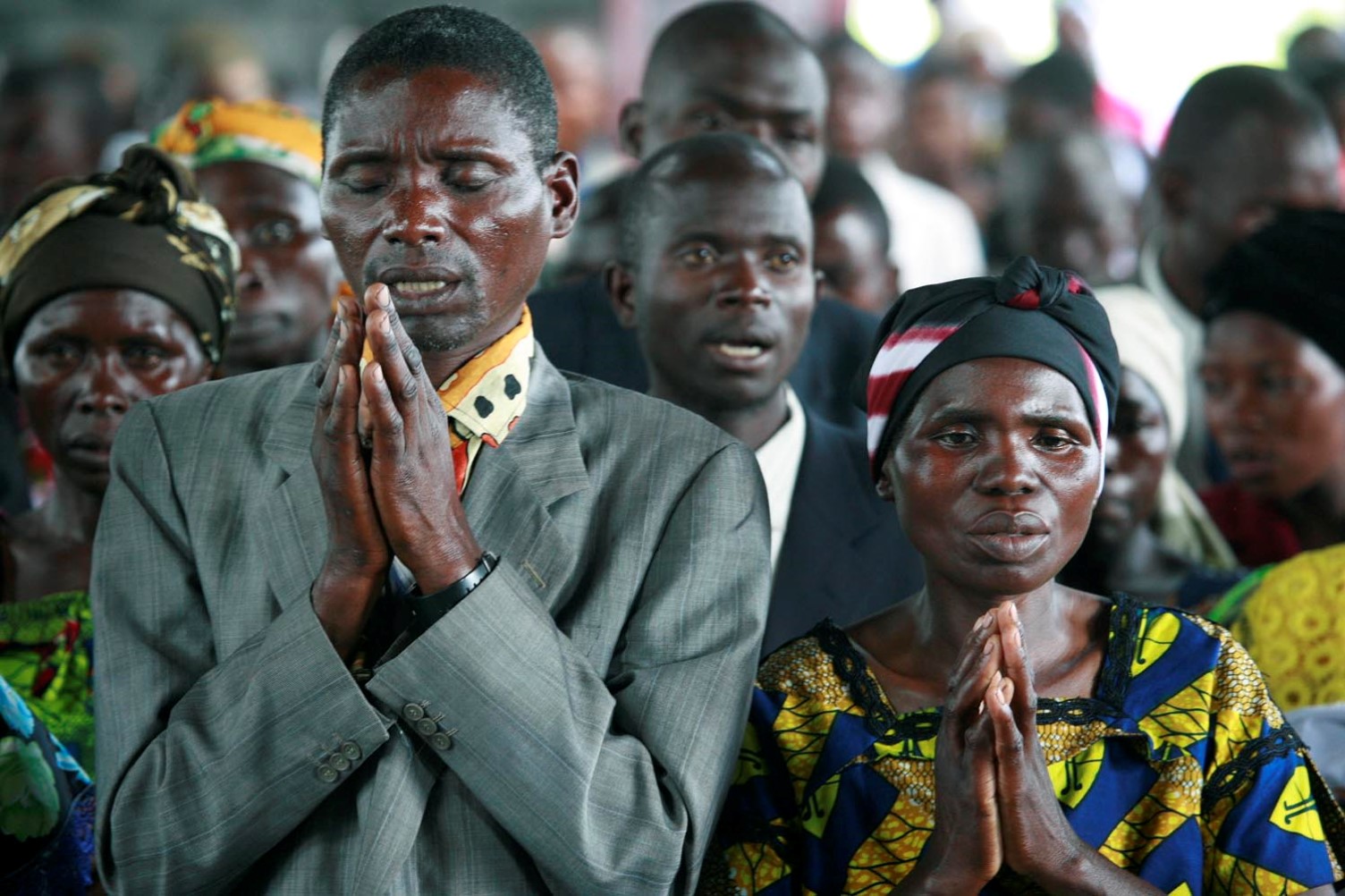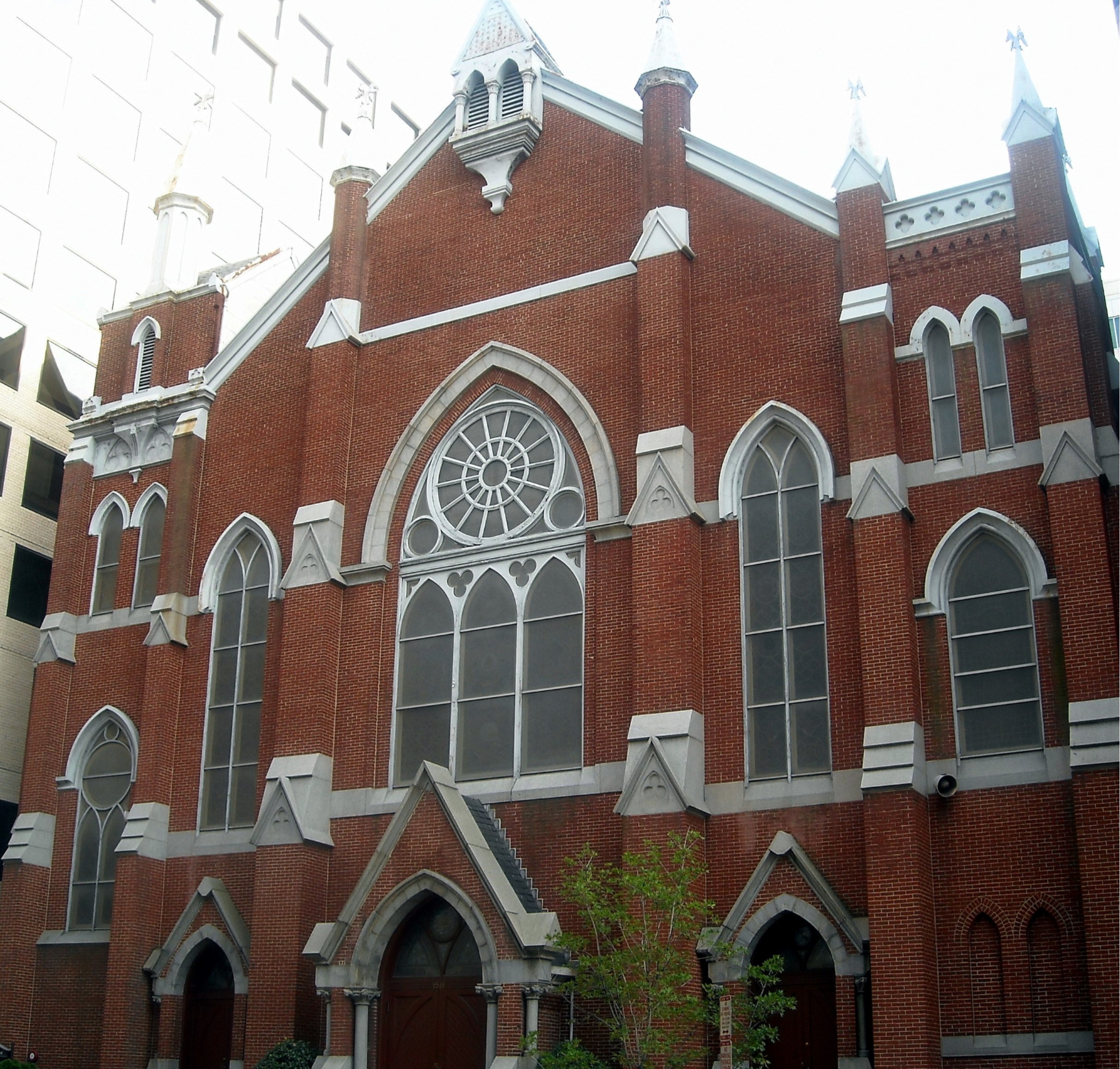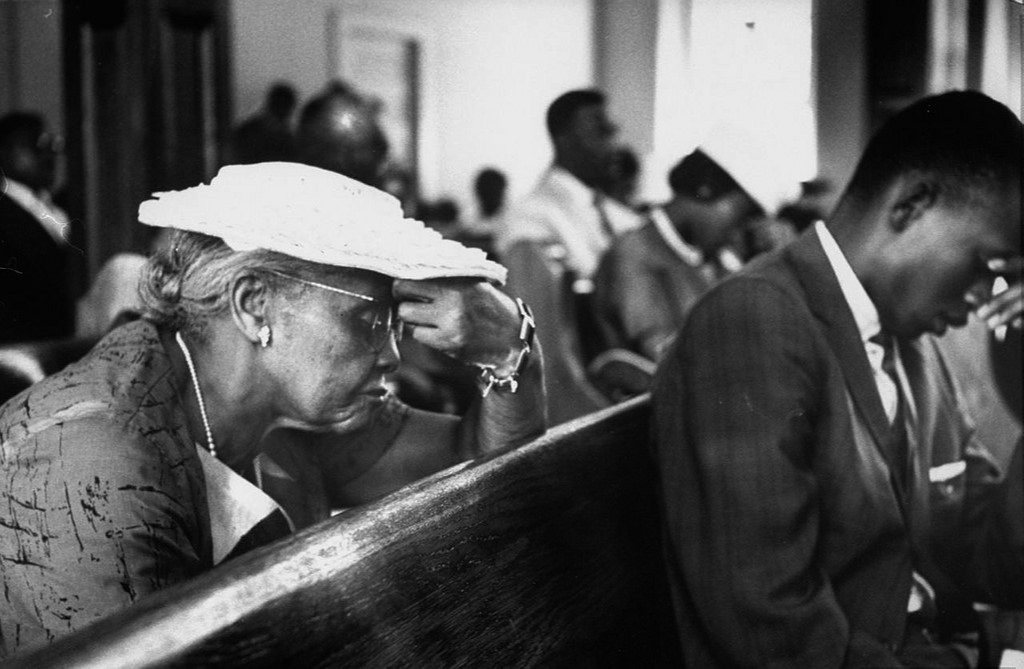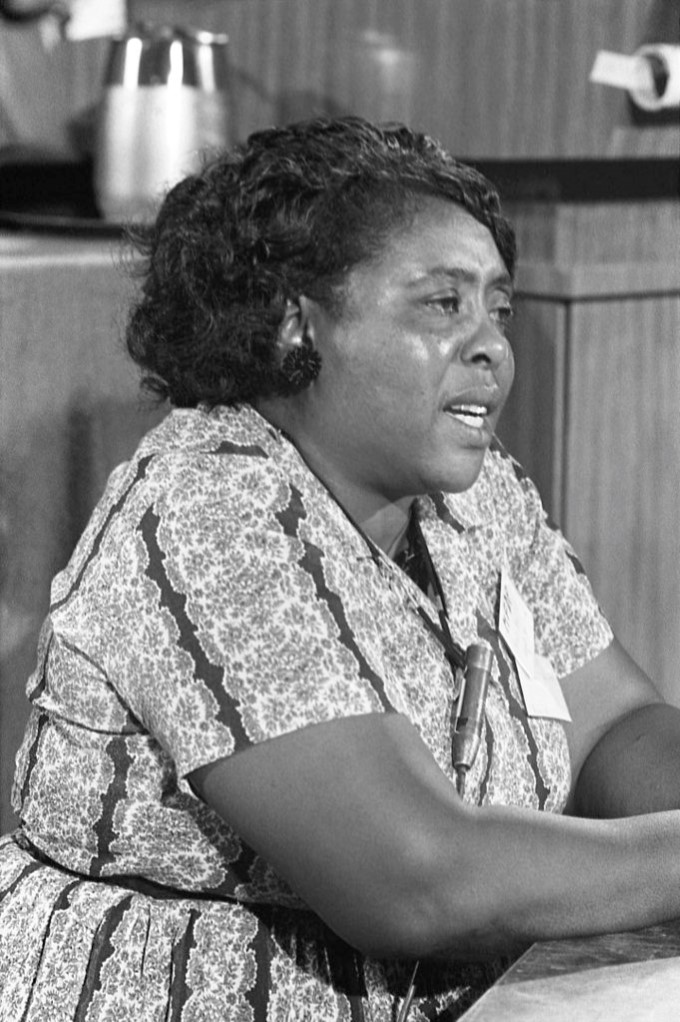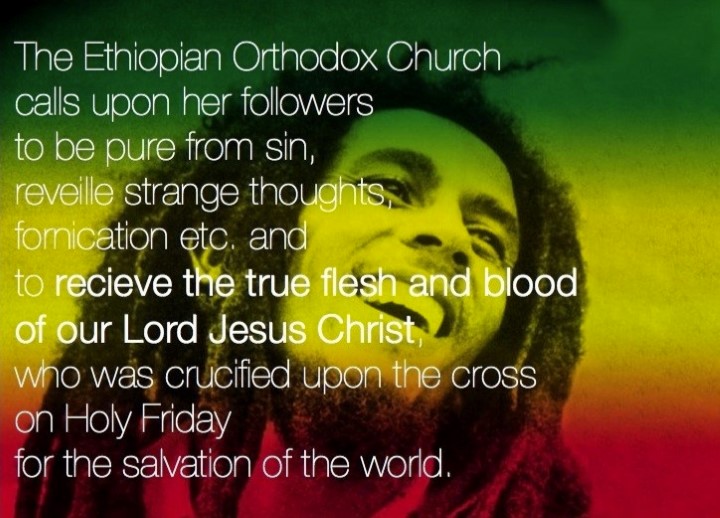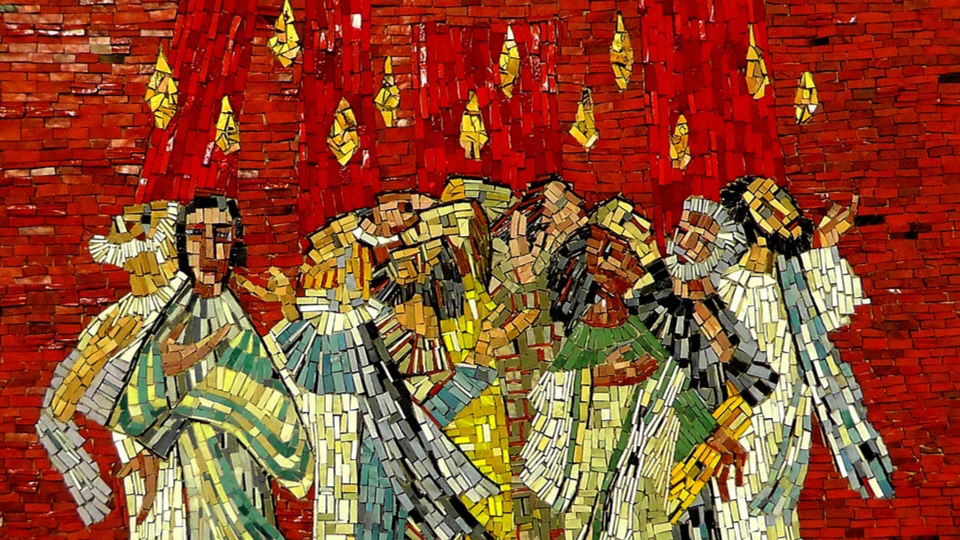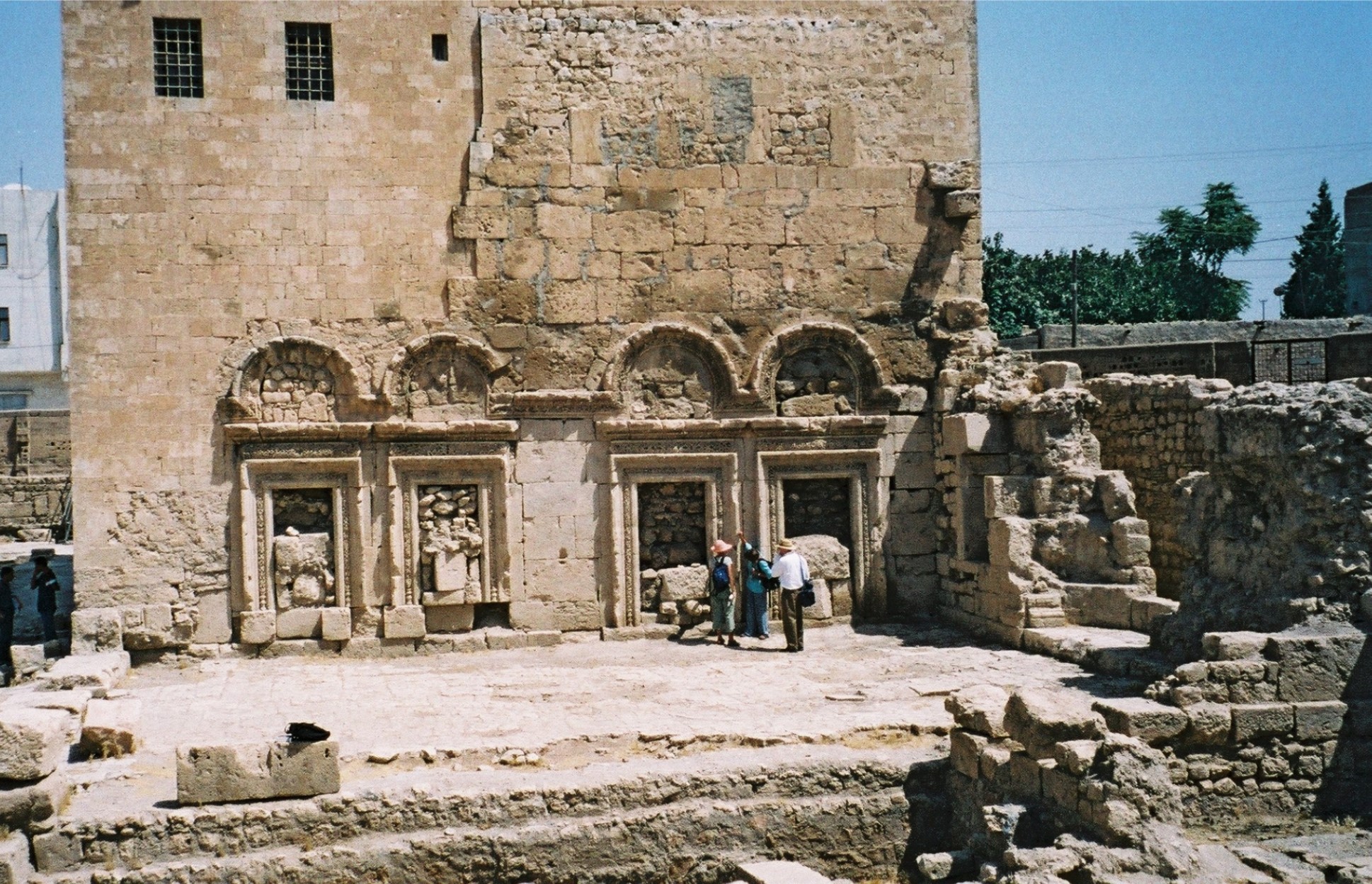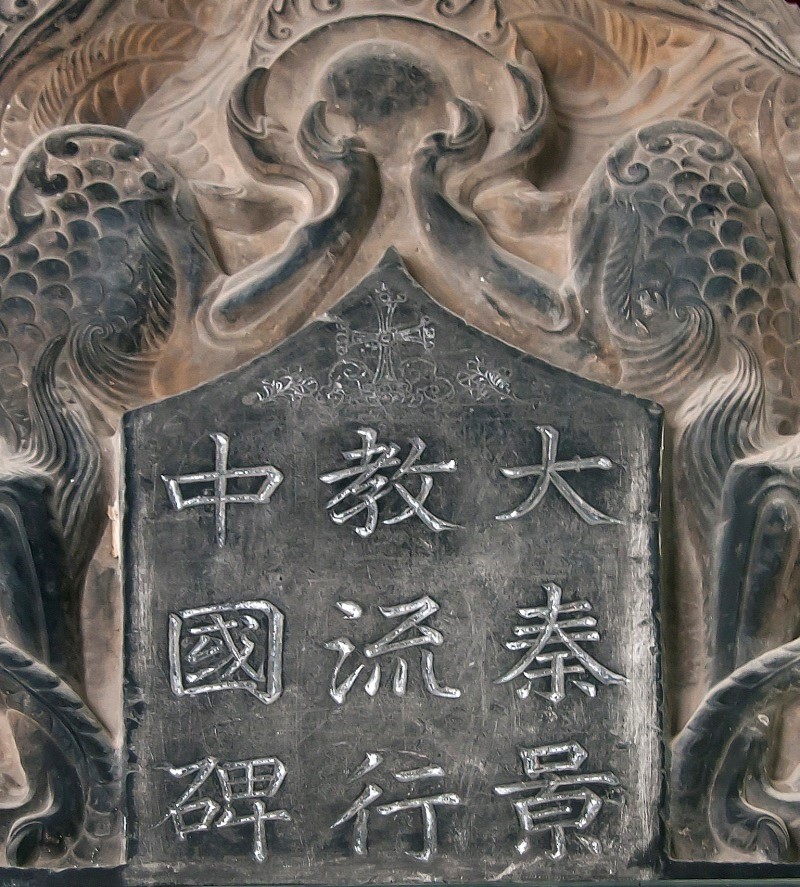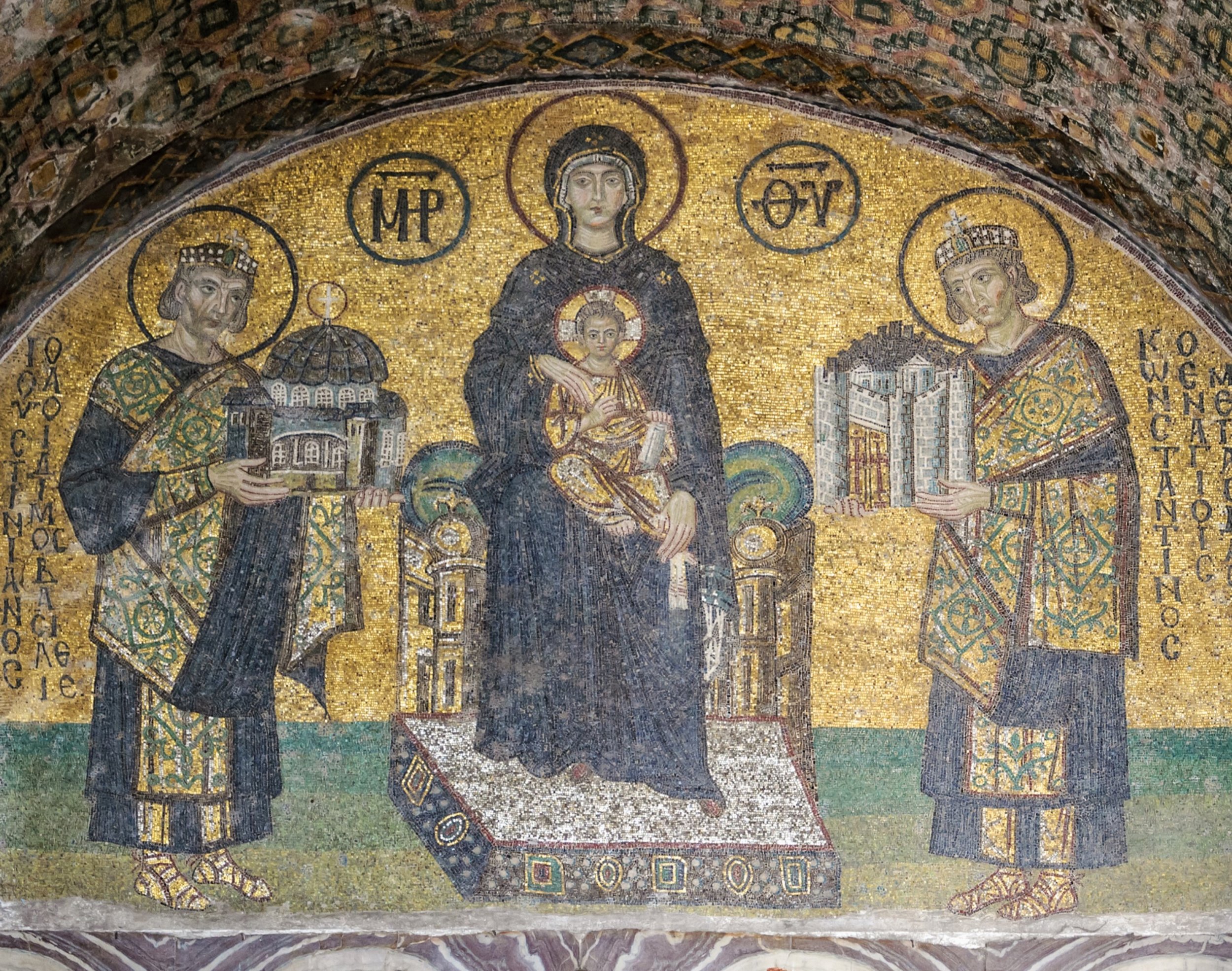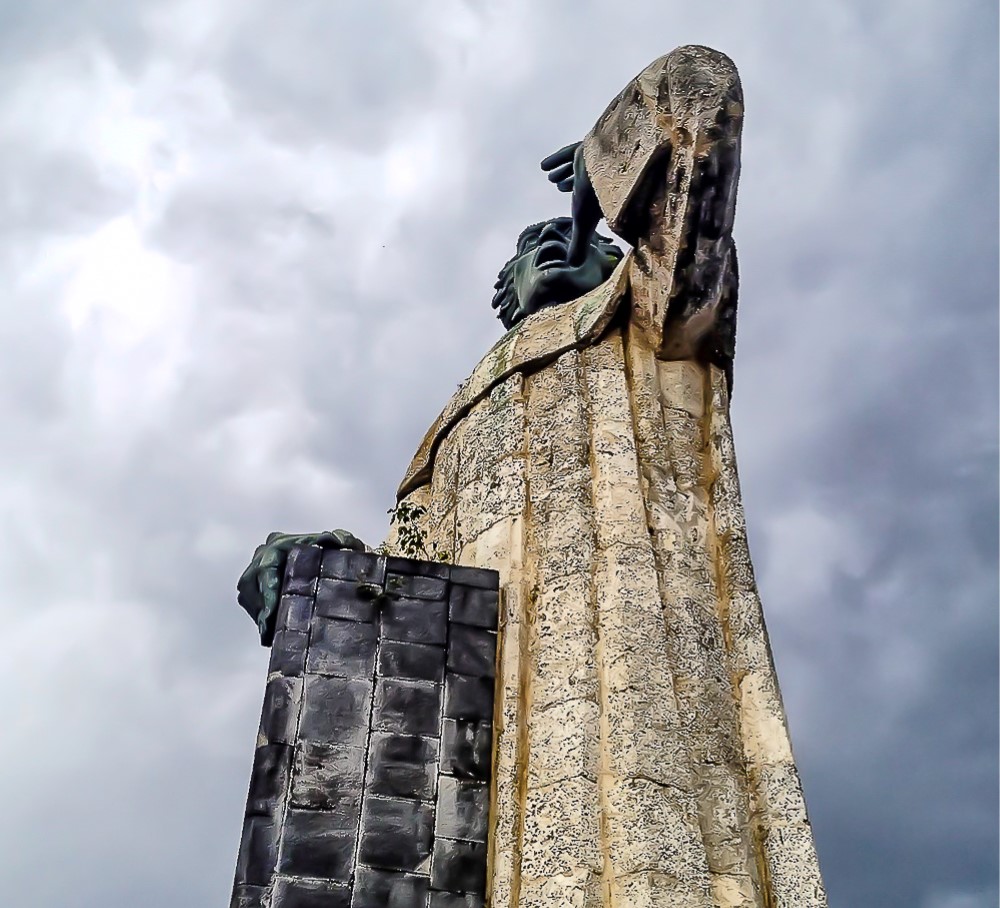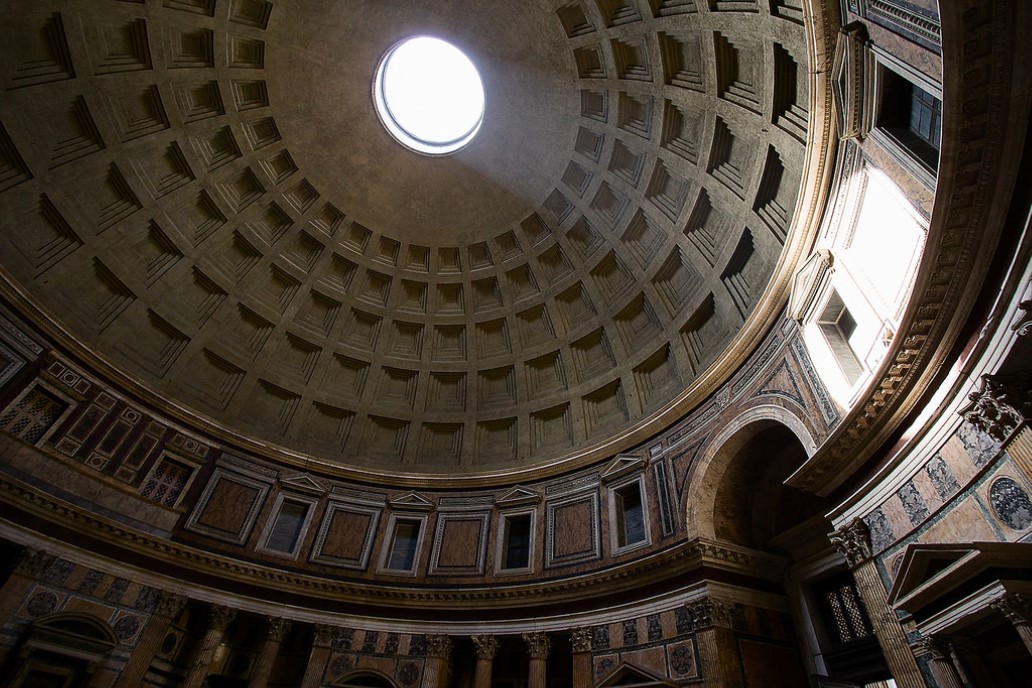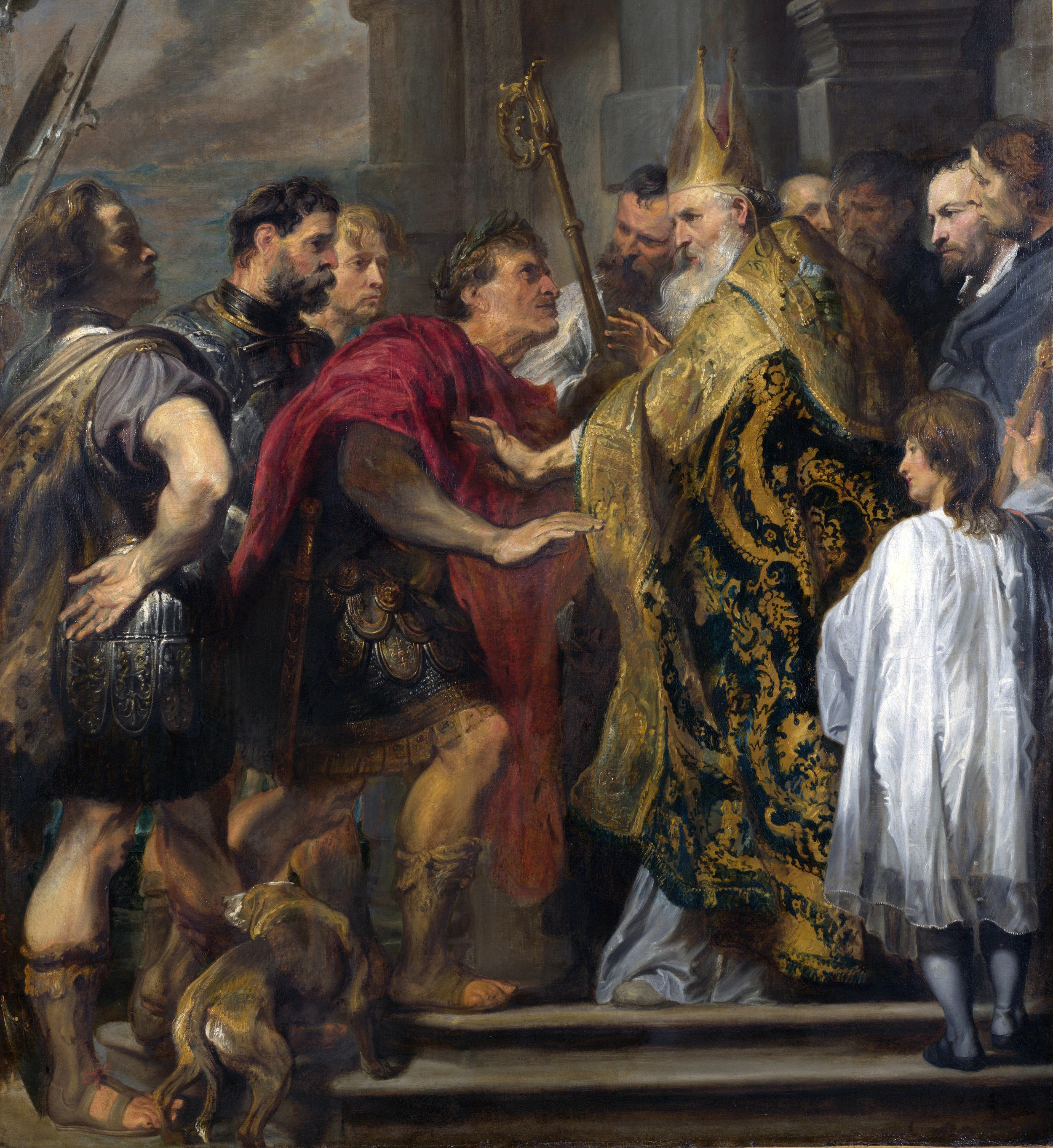The Church in Africa
30 - 1600 AD: Cradles of Christian Civilization
Photograph: The excavated Faras Cathedral from the Nubian Christian civilization in the Upper Nile Region. Depicted is the birth of Christ, with Mary reclining, surrounded by angels. Photo credit: Tadeusz Biniewski | CC3.0, Wikimedia Commons. The story of Nubian Christianity is remarkable. At around 540 AD, the warring kings and kingdoms of Nobatia, Makuria, and Alodia (all now Northern Sudan) became Christian at roughly the same time. They reconciled their differences and merged their kingdoms. This led to a flourishing literary and artistic culture in the Upper Nile region. See what is known about the Kingdom of Makuria and artwork in the Faras Cathedral: the fiery furnace in Daniel, Mary and Infant Jesus, the Cross and Four Living Creatures, and Madonna and Child with Bishop Marianos. The Nubians resisted and/or survived Arab Islamic military advances until around 1500 AD. Here are other Nubian Christian frescoes. The National Museum in Warsaw, Poland has constructed the Faras Gallery to display the artwork.
Introduction
The selection of perspectives on church history in this section — Church and Empire — has been guided by three factors: (1) to demonstrate that Christianity has not been a “white man’s religion”; (2) the study of empire as a recurring motif in Scripture by recent biblical studies scholars; and (3) explorations of biblical Christian ethics on issues of power and polity, to understand how Christians were faithful to Christ or not. Christian relational ethics continues a Christian theological anthropology that began with reflection on the human nature of Jesus, and the human experience of biblical Israel.
This page explores Christians in Africa relating to power prior to 1600.
Messages and Resources on the Church in Africa Pre-1600
Part 2: Wakanda — Not Conquered, Not Conquerors — A Portrait of a Chosen People? Part 2 of a five part series on The Theology of Marvel’s Black Panther explores the portrait of Wakanda as Afro-futurist but also a near-ideal people in a world where colonization is the rule, not the exception. Wakanda is linked to Ethiopia in that sense: an uncolonized Sub-Saharan African nation. The Ethiopian cross is even present in the movie. And Ethiopia's Christian faith is also important in real history, as a force against Western European influence during the older age of colonialism, as well as the modern age of capitalism. Wakanda is also a "chosen people" image also portrayed by the Hebrew Bible, especially when we look at a human community in a garden land, who have received a divine from above, resulting in the power of women and more.
Dr. Vince Bantu, Assistant Professor of Church History at Fuller Seminary and Founder-Director of the Meachum School of Haymanot, joins Mako Nagasawa to appreciate Marvel's Black Panther. We talk about church history, Christian ethics and theology, and the lessons we need to learn today.
Our video series, The Theology of Marvel’s Black Panther, is also found on our Arts and Theology page and our YouTube channel, where we put brief descriptions of each video. It’s a great way to engage people who have an appreciation for the movies, especially if they are also activists at heart, and wonder why we firmly argue that Christian faith is not a “white man’s religion.”
Slavery: How the Early Church Got It Right
Presentation given October 2, 2021 to the Reconstruction class. Explores early Christian emancipation and abolition. While Christians did not eliminate all forms of servitude, since servitude for civic penalties, indebtedness, war captivity, and self-indenture persisted, Christians eventually did eliminate what we know as chattel slavery. The presentation examines Old Testament institution of the Hebrew ebed servant, and the New Testament approach to Greco-Roman modes of servitude. We glance at how colonialism and Trans-Atlantic slavery deformed traditional Christian teaching, mindful that more slavery exists today across the globe than every before, and that in the U.S., indebtedness and incarceration show that we have greatly exaggerated the claims that the U.S. has done better than the Bible on “slavery” and its constellation of challenges.
Slavery in Christianity, Part 1: Slavery in the Bible, Slavery Today
Research and slides which explores the Old Testament, then the New Testament. It looks at what the Hebrew "ebed" service meant in context, and then what Greek "duolos" meant and how the New Testament understood the various ways people could enter servitude. It uses a sociological approach, exploring different ways in to becoming an “ebed” or “duolos,” what rights and responsibilities those roles had, and how one could leave and/or escape.
Slavery in Christianity, Part 2: Abolitionism from the First to Fifteenth Century
Research that demonstrates that, although “slavery” was a complex phenomenon and varied across cultural groups and time periods, Christians understood the Bible as being against chattel slavery, and most other forms as well, and that Christian faith began to abolish slavery immediately, eventually formally abolishing it in northwestern and northern Europe by the 1300’s, despite the political upheavals and rising and falling of various political regimes. I am aware of ups and downs, because kingdoms rose and fell, regimes changed, and governments were not always consistent. Nevertheless, these historical record challenges the narrative that Christianity is ambiguous at best on slavery. Rather, Christianity is the only belief system that has generated abolitionist and anti-trafficking movements. See also Slavery in Islam: From the Seventh to Twenty First Century, which raises serious questions for both Muslims and also secularists who might want to argue that all belief systems are the same, etc.
Slides to a presentation given to the 2022 Reconstruction class, accompanying the video. Greek and Roman views of the inferiority of women began with Plato and Aristotle (4th century BC). But Pulcheria was a Christian woman who became Roman augusta in 414 AD and presided over the Third and Fourth Ecumenical Councils. Empress Theodora was very influential in the 500s. And Irene became Emperor of the Romans by 800 AD. How did this happen? This presentation explores vocation as the main category by which Christians empowered women in roles distinct from family, examining the Catacombs of Priscilla, Irenaeus of Lyons, The Acts of Paul and Thecla, the Martyrdom of Perpetua and Felicitas, Montanism and the orthodox reaction to it, Melania the Elder, Paula of Rome, Nino of Georgia, Brigit of Ireland. The presentation also discusses the disagreements between Irenaeus, Tertullian, and Origen about how to interpret women in 1 Corinthians 11.
The Goodness of God and the Healing of Creation According to Athanasius of Alexandria
Slides to a presentation given to the 2022 Reconstruction class. It spotlights Athanasius’ teaching on the following topics: creation; corruption; clinical trial in Israel; cure in Jesus; consummation. This is a good introduction to the broad thought of the early Christians, since Athanasius is considered a faithful spokesman. It also pays special attention to penal vs. medical substitutionary atonement, which introduces us to the contrast between divine retributive vs. restorative justice.
Politics, the Church, and Jesus’ Restorative Justice
Slides of a presentation given to the 2022 Reconstruction class. The introduction features John Winthrop vs. Roger Williams to highlight the debate over freedom of religious Conscience vs. Christendom. The presentation highlights Christian accomplishments in health and hospitals, education and schools, land ownership and economic justice, and criminal justice reform.
Slides to a presentation given October 16, 2021 to the first Reconstruction class, which was consolidated into the 2022 class. Summarizes the remarkable dignity that Christians perceived in children, who had no inherent dignity or status in pagan Greco-Roman cultures. This impacted views on infanticide, abortion, social welfare, and education. Based on outstanding research by O.M. Bakke, When Children Became People: The Birth of Childhood in Early Christianity.
The Council of Nicaea, the Origin of “the Trinity,” and the Limitations of Human Language
Slides of a presentation given October 30, 2021 to the Reconstruction class. This presentation covers the conceptual and linguistic factors that led to the need to explain the Father-Son relation at the Council of Nicaea, the anti-Nicene reaction, Athanasius’ leadership advocating a pro-Nicene position, and the articulation of the Constantinopolitan revision of the Creed in 381 AD.
The Council of Nicaea, the Origin of "the Trinity," and the Role of Political Power
Slides of a presentation on the political history of the Council of Nicaea in 325 AD, and its later political significance — important because of the role of Athanasius of Alexandria and the later impact of the Chalcedonian Creed on Coptic Church.
Christian Mysticism: Are We Missing Something?
Slides to a presentation. These practices originated in Egyptian monasticism — the Jewish therapeutae and the Christian monastics.
Free Will and God’s Grace in Patristic Theology
Quotations from early church theologians; refutes determinism, which inevitably makes God the author of evil. This document shows how Augustine of Hippo was a problematic aberration from all who came before him.
Penal Substitution vs. Medical Substitution: A Historical Comparison
An analysis of the atonement theology ("medical substitution") of early church theologians, including Ignatius of Antioch, Irenaeus of Lyons, the Odes of Solomon, Justin Martyr of Rome, Melito of Sardis, Tertullian of Carthage, Methodius of Olympus, Athanasius of Alexandria (paper in progress to include later theologians, bishops, and councils).
Text and slides of a message about the role Christian faith played in history, bringing about hospitals, abolition of slavery, education, science and technology, beauty and the arts.
Other Resources on the Church in Africa Pre-1600
Africa, General:
Calvin E. Shenk, “The Demise of the Church in North Africa and Nubia and Its Survival in Egypt and Ethiopia: A Question of Contextualization?” Missiology Sage Journals, 1993.
Elizabeth Isichei, A History of Christianity in Africa: From Antiquity to the Present. Eerdmans | Amazon page, Feb 22, 1995.
Aloys Grillmeier with Theresia Hainthaler. Christ in Christian Tradition: Vol. 2 From the Council of Chalcedon (451) to Gregory the Great (590-604): Part 4 The Church of Alexandria with Nubia and Ethiopia After 451. Westminster John Knox Press | Amazon page, 1996.
Kwame Bediako, Jesus in Africa. Authentic UK | Amazon page, Nov 30, 1999, republished as Kwame Bediako, Jesus and the Gospel in Africa. Orbis Press | Amazon page, 2004.
Egyptian Church:
Ambrose Andreano, The Desert Fathers (Patristics Project) re: the Egyptian Christian monastic movement which later spread throughout the world and became the Orthodox monasteries and Catholic orders, and even Protestant parachurches.
Wikipedia, Moses the Black (Wikipedia article) 330 - 405 AD.
Otto F.A. Meinardus, Monks and Monasteries of the Egyptian Desert. The American University of Cairo Press | Amazon page, Feb 1, 1989.
Otto F.A. Meinardus, Two Thousand Years of Coptic Christianity. The American University of Cairo Press | Amazon page, 1999.
Haggai Erlich, The Cross and the River: Ethiopia, Egypt, and the Nile. Lynne Rienner Publishers Amazon page, 2001, 2014. Erlich traces the history involving competing claims on the Nile and the role of the Christian churches in both countries.
Massimo Capuani, Christian Egypt: Coptic Art and Monuments Through Two Millennia. Liturgical Press | Amazon page, Sep 1, 2002.
Abba Abraham Buruk Woldegaber and Mario Alexis Portella, Abyssinian Christianity: The First Christian Nation? The History and the Identity of the Ethiopian and Eritrean Christians. BP Editing | Amazon page, 2012.
Philip Jenkins, Shenoute the Great. Patheos, Aug 9, 2013. Jenkins discusses the 4th century Coptic leader of the White Monastery in Upper Egypt.
John R. Gresham, Jr., Athanasius: Relevance in the Black Church Today. blog, Jun 26, 2014.
Vince Bantu, Is Christianity the White Man's Religion? Jude3 Project, Jun 20, 2016. about Christianity in Egypt from the 2nd to 7th centuries and Vince Bantu, Mis-Reformed, the Imperialism of Reformed Theology. Urban Perspective, Feb 18, 2018.
Libya, North Africa:
John Gallagher, Byzantines Beat the Vikings to America by 500 Years. Diakonia, Jul 11, 2009. re: North African Orthodox Christians fleeing the Vandal invasion, landed in present day Connecticut.
Thomas C. Oden, Early Libyan Christianity: Uncovering a North African Tradition. InterVarsity Press | Amazon page, Oct 28, 2011.
Ethiopian Church:
Wikipedia, Ezana of Axum (Wikipedia article) 320's - 360 AD, first Christian king of Ethiopia.
Wikipedia, Abuna Yemata Guh (Wikipedia article) re: the Ethiopian monolithic rock churches in the northern, Tigray region of Ethiopia, hewn from the sixth century, honoring the Nine Saints (Wikipedia article) from Rome, Constantinople, and Antioch, and decorated with Ethiopian mosaics dating back to the fifteenth century.
Raymond Davis, Fire on the Mountains: The Story of a Miracle – the Church in Ethiopia. Sudan Interior Mission | Amazon page, 1966.
Aymro Wondmagenehu and Joachim Motovu, The Ethiopian Orthodox Church. Ethiopian Orthodox Mission | Amazon, 1970.
Steve Kaplan, The Monastic Holy Man and the Christianization of Early Solomonic Ethiopia. Coronet Books | Amazon page, 1984.
David W. Phillipson, Ancient Churches of Ethiopia. Yale University Press | Amazon page, 2009. See also Ezana (Abreha) (Ancient World History website). Tekletsadik Belachew, “From Abba Salama to King Lalibela: Christian Traditions in Ethiopia are among the Oldest in the World”. Christian History Magazine, 2013.
Seraphim Danckaert, BBC Documentary on Ethiopian Orthodox Christianity (Orthodox Christian Network, Jun 25, 2014.
Marg Mowczko, Queen Candace of Ethiopia. Marg Mowczko, Jan 24, 2015. This is a short, readable history of queen regnants in Ethiopian Christianity.
Mario Alexis Portella, Ethiopian and Eritrean Monasticism: The Spiritual and Cultural Heritage of Two Nations. BP Editing | Amazon page, 2015. Portella tells the remarkable history of how Ethiopian Christians interacted with European counterparts from the 5th century to the Council of Florence in 1441, served as a rallying point for Ethiopian ethnic and national identity against the Portuguese Jesuits in the 17th century, and the Italian fascist invasion of 1935.
Daniel Assefa and Tekletsadik Belachew, “Values Expressed through African Symbols: An Ethiopian Theological Reflection.” International Bulletin of Mission Research. Sagepub Journal, 2017. Assefa and Belachew study the symbolism, poetry, hymns and chants.
Haile Getatchew, The Ethiopian Orthodox Church's Tradition on the Holy Cross. Brill | Amazon page, 2017. Getatchew presents theological and liturgical material reflecting on the crucifixion of Jesus.
Thomas C. Oden, The Songs of Africa: The Ethiopian Canticles. ICCS Press | Amazon page, 2017. Oden traces this early musical notation format to modern jazz.
Christian C. Sahner, Discoveries in the Ethiopian Desert. Marginalia, Mar 17, 2017. Sahner describes the Ethiopian Garima Gospels manuscripts.
Ralph Lee, Symbolic Interpretations in Ethiopic and Early Syriac Literature. Peeters Publishers | Amazon page, Oct 18, 2017. Lee explores the influence of Syrian Christianity on Ethiopian Christianity in the earliest centuries.
Zac, The Tigray Churches Are the Most Beautiful Confluence of Culture, Nature, History, and Adventure. New Faces, New Places, Nov 11, 2017. Zac is an Australian photographer who offers a tourist’s and adventurer’s perspective, with beautiful pictures.
Philip F. Esler, Ethiopian Christianity: History, Theology, Practice. Baylor University Press | Amazon page, 2019.
Dirshaye Menberu, Estifanos of Ethiopia. Dictionary of African Christian Biography. Estifanos (1380 - c.1450 AD) was an Ethiopian scholar and reformer of the Ethiopian Church who bears curious resemblances to the European Protestant Reformers.
Wikipedia, Walatta Petros (Wikipedia article) (1592 - 1642) one of the 21 female saints in the Ethiopian Orthodox Church; Petros is celebrated for resisting the influence of Roman Catholicism in Ethiopia.
Wikipedia, Giyorgis of Segla (Wikipedia article) (c.1365 - 1425) an important Ethiopian Orthodox writer in the 15th century.
David M. Perry and Matthew Gabriele, A New History Changes the Balance of Power Between Ethiopia and Medieval Europe. Smithsonian Magazine, Jun 29, 2021. “For centuries, a Eurocentric worldview disregarded the knowledge and strength of the African empire”
Nubian Church:
Giovanni Vantini, Christianity in the Sudan. EMI | Amazon page, 1981.
Paul Bowers, “Nubian Christianity: The Neglected Heritage,” East African Journal of Evangelical Theology (Biblical Studies, 1985.
Derek A. Welsby, Medieval Kingdoms of Nubia: Pagans, Christians and Muslims in the Middle Nile. Bryn Mawr Classical Review | Amazon page 2002.
Peter C. Nadig's book review. Roland Werner, William Anderson, and Andrew Wheeler, Day of Devastation, Day of Contentment: The History of the Sudanese Church across 2000 Years. Paulines Publications Africa | Amazon page, 2010.
Adam Lajtar, J. van der Vliet, Grzegorz Ochala, and Giovanni Ruffini, Nubian Voices: Studies in Nubian Christian Civilization, Journal of Juristic Papyrology Supplements. Journal of Juristic Papyrology Supplements | Amazon page, Oct 31, 2011.
Salim Faraji, Roots of Nubian Christianity Uncovered: The Triumph of the Last Pharaoh. Africa World Press | Amazon page, Jul 25, 2012.
Kings and Generals, Nubia - Christian Kingdoms in the Heart of Africa. Kings and Generals, Feb 9, 2021. This is a helpful 21 minute video from Egyptian occupation of Nubia to independent Kush (~745 BC), relations with Rome and Aksum, Christianization via Alexandria (580 AD), relations with Islamic powers; relations with the Egyptian Copts. The King of Nubia was a priest and could perform services, raising fascinating and troubling questions. Society including the royal line was matrilineal, so women had civic power.
Samantha Kamman, Archaeologists Discover Ancient Christian Artwork in Hidden Underground Medieval Complex. Christian Post, Apr 13, 2023.
Sub-Saharan Africa:
Linda M. Heywood and John K. Thornton, Central Africans, Atlantic Creoles, and the Foundation of the Americas, 1585-1660. Cambridge University Press | Amazon page, 2007. Heywood and Thornton detail the remarkable story of how King Afonso of Kongo became a baptized Catholic in 1491, one year before Columbus set sail for the Americas, and fully welcomed more Catholic priests and missionaries. In a few years, up to 20% of the West African people taken as slaves to the Americas were Catholic Christians; this means that church history had to be falsified in order for the Catholic Doctrine of Discovery to take effect; see also John Thornton, The Development of an African Catholic Church in the Kingdom of Kongo, 1491–1750. The Journal of African History, Jan 1, 2009. To see the ramification of this history among Protestants and Catholics in the U.S., see the Protestant theologian and professor, David Daniels III, 1619 and The Arrival of African Christianity. McCormick Theological Seminary, Sep 3, 2019. See the Catholic discussion between Matthew Davis and Father Gerard Marable, The Journey from 1619 for the Catholic Church. Catholic Star Herald, Nov 21, 2019. Daniels writes:
“The Africans of 1619 came to North America, according to Thornton and other scholars, from one of the most Christianized regions in Africa: the Empire of the Kongo and its neighboring kingdoms of Loango and Ndongo located along or near the west-central African Atlantic coast. By 1619, the Kongolese Empire possessed its own cathedral, churches, lay Christian societies, and schools for girls and boys; Africans served as Catholic priests, catechists, church musicians, school principals, school teachers, court scribes, and Christian monarchs; in the prior century, there even existed a Catholic bishop of Kongolese descent. At the Catholic college in the nearby Portuguese colonial outpost at Luanda, Africans were enrolled as students and were among the graduates. In comparison to the Kongo of 1619, early colonial Virginia was an undeveloped Christian society.”
John Thornton and Linda Heywood, A Forgotten African Catholic Kingdom. The Root, Aug 12, 2011. This led to the Stono Rebellion of 1739 in South Carolina (Wikipedia article), led by Catholic Kongolese-Americans; see Lisa Vox, What Impact Did the Stono Rebellion Have on the Lives of Slaves? Thoughtco, Jan 13, 2018.
Nehemia Levtzion and J.F.P. Hopkins, Corpus of Early Arabic Sources for West African History. Markus Wiener Publishers | Amazon page, May 2011. Levtzion and Hopkins show historical evidence of an established Christian community, living in the gold-rich kingdom of Mali under Mansa Musa in the year 724 (Muslim) /1324 (Christian) — see below. Implies that Sub-Saharan West Africa was probably evangelized by indigenous Africans. It means that the Portuguese and then Spanish and other European slave traders lied — they did, in fact, kidnap fellow Christians into slavery. It means that the pathetic excuse of tying evangelism to enslaving others falls apart not just on moral grounds but on historical, factual grounds, too.
Church and Empire in Africa: Topics:
This section explores the experience and activities of Christians under various regimes in Africa. We divide this material into Africa Pre-1600, Africa Post-1600, African American Pre-1954, African American Post-1954, African American Spirituality, and the African Diaspora outside the U.S. The time period around 1600 AD is significant because: In the West, the Songhai Empire collapsed in 1591 and the Mali Empire was divided in 1610; in Central Africa, Idris Alooma, ruler of the Kanem-Bornu Empire, died in 1603; in the East, Portugal and the Catholic Church were expelled from Ethiopia in 1632; and on the coasts, accelerated conflict with European colonizers and slave traders
Church and Empire: Topics:
This page is part of our section on Church and Empire. These resources begin with a biblical exposition of Empire in Church and Empire and the meaning of Pentecost in Pentecost as Paradigm for Christianity and Cultures, then grouped by region: Middle East, Asia, Africa, Europe, Americas, then Nation-State, with special attention given to The Shoah of Nazi Germany.



